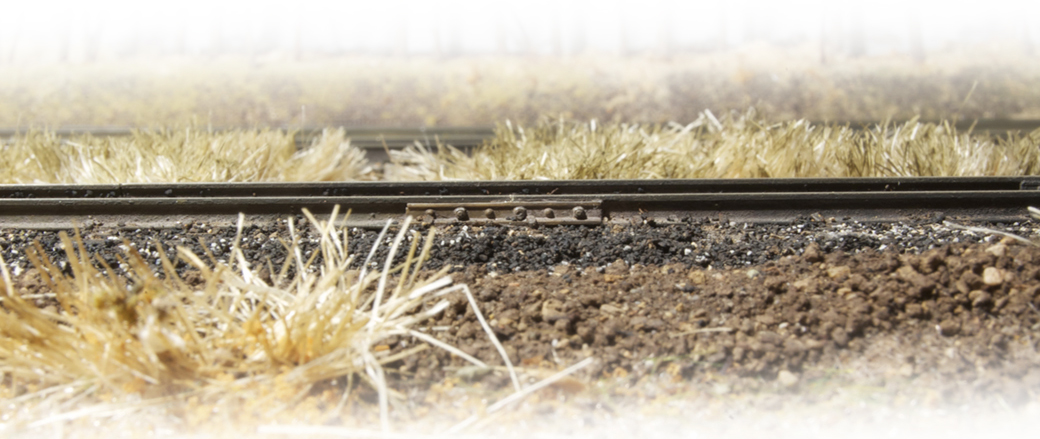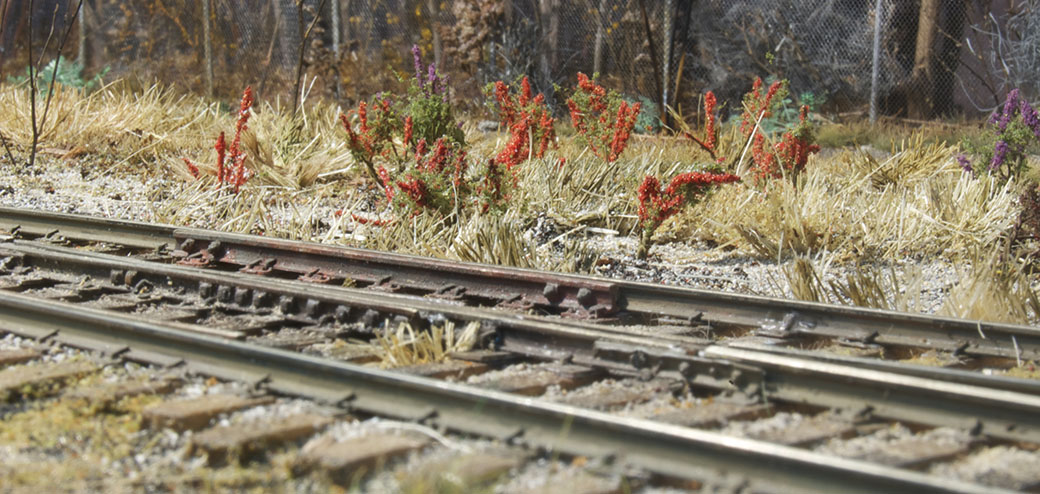Modeling Track: Introduction

Handlaid or commercial?
It’s a choice that can paralyze people. Each has positive and negative aspects and I won’t rehash those in this post as they are well known and merely scratch the surface. I find that unless there is a clear advantage of one choice over another, such lists aren’t that helpful. Instead, I’d like to approach this from another perspective.
Let’s agree that there is a wide range of opinion and that everyone has different goals to pursue in relation to the craft. Track may be a major or minor focus for you depending on what your goals are. I’m not offering a prescriptive formula here, merely some insights about the choices I made personally.
What Do You Want From Your Track?
We ask a lot of model track. Of everything that goes into a layout, the track probably has the most demands placed upon it. Track serves a dual purpose in that it needs to be functional and mechanically sound, while delivering a cosmetic appearance that can either add to or detract from the rest of the layout.
Mechanically sound track that guides and powers the train doesn’t have to be pretty (think vintage three-rail tubular track) to do its job; whereas cosmetically accurate track also has to be mechanically sound to serve its intended purpose. It’s this dual aspect that gives many of us trouble. It’s not an issue of choosing between mechanics and beauty; the issue comes from the other expectations we bring related to quantity and quality. Builders of larger layouts want speed and ease of getting the track down along with cost savings due to the volume of materials their plan might require. They’re willing to make compromises that others, for various reasons, would not. This brings us to the question of what do you want from your track?

Several things add to the realism of this scene such as the boltheads on the wing rail of the frog and the ends of the guardrail. Less obvious is the air space under the rail between each cross tie. We expect to see this on full-size track and here it adds to the illusion I’m creating. On most brands of flex track this space would be filled by the plastic webbing that connects the tie strip. Details that detract are the funky joint bar on the right and oversized heads on the spikes.
Understand Your Expectations And The Tradeoffs
Working in quarter-inch scale dictated a few choices for me from day one. Primary among them was at that time I started building the layout (roughly 2006-08) flextrack or commercial turnouts weren’t readily available in P48. I didn’t see this as a problem since I already decided to scratch build my track. Another contributing reason for this choice was the perspective of the scene. With a narrow shelf layout the track was in plain view and easy to study at close range. From this viewpoint missing or crudely rendered details are obvious.
I also had very high visual expectations. As I mentioned in the previous post, this track was the culmination of a long pursuit of greater realism in my track modeling. I chose appearance over convenience because I knew I could build in reliability from the outset. This is why I stress knowing your “why.” By clearly understanding my goals even though certain choices were limited by default, those within my control were easy to make. Had I been less concerned with realism and planned a different kind of layout, commercial five-foot gauge track systems might have been a viable option. On the surface they certainly would have been easier and quicker but I couldn’t stomach the compromised appearance or gauge.
The appearance of the track also contributed to the overall scene I created with the layout. Since I could control the quality, I could blend the track into the greater landscape seamlessly, which added to the impact the layout had. For example, I used continuous stock rails and eliminated the rail joints at both ends of each turnout. This small detail gave my track the same cohesive look we see on the real thing.
Realism suffers when one element of an otherwise cohesive scene sticks out from the rest. Historically, track has been treated as one of those things that gets a free pass from many people. We’ve all seen images of finely built rolling stock running on crude track, or surrounded by poorly done generic scenery. We’ve accepted this dichotomy without question yet our jaws still drop when someone gets all the elements right. Why? Because the image conveyed is consistent. No indifferently rendered single detail destroys the illusion we’re trying to create.
As mentioned earlier I’m aware these are choices one makes. I’m a strong believer in learning new skills that empower a modeler toward a more engaging experience of the craft. The ability to handlay track is one such skill and the options and subsequent rewards it offers deserve to be better known.
So, what do you want from your track? It’s worth the time to clarify your expectations because the alternative often leads to disappointment and wasted resources and, is that what you really want from this hobby?
Regards,
Mike
I am a bit torn on this myself. I am still looking at what I want to model and I have several options….one requires 22 turnouts and most of the trackage is buried in the street—ala Kingsbury Avenue in Chicago. The other options are either small town switching such as Lynden, WA, or urban switching such as the area in Sioux Falls south of the airport, or an industrial park such as the Factory District in which the Des Moines Union Railway operated.
I would be a bit of a nut to hand lay all of the trackage that gets covered up but I don’t know of any flex track available in P48 at code 100. And do I really want to hand lay 22 turnouts…..? Lynden and Sioux Falls have a small number of turnouts and trackage itself is not long so I can see my self easily detailing all of the trackage. DMU factory district starts to move toward a higher number of turnouts but still a decent amount of trackage that can be detailed.
Decisions ….decisions
Hi Michael,
I love the Kingsbury line. I’m also drawn to track in pavement and always thought doing it in P48 would be a wonderful opportunity to explore track modeling and detailing. If I were ever to model street trackage, I’m not certain I would bother with all the detail in areas with solid pavement. I would include such detail near the fringes and edges because I tend to design on the fly. I’d want them to be there if I modeled broken or crumbling sections of pavement.
One thing I discovered the hard way with quarter-inch scale is how easily you can overcrowd a scene with track. It takes up more space than people think and doesn’t leave room for surrounding scenery, especially in a space like a narrow shelf for example. That’s why I removed portions of track from the old layout. Doing so opened up the scene and the extra breathing room added to the realism. I also discovered that one doesn’t need as much operation as the gurus suggest. In this scale, small movements and smooth running convey more than in smaller scales. It’s a hard sell until people experience it for themselves.
Mike
I think everything you say here is true not just of track, but of any aspect of modelling, and can be recast as, “Hand made or commercial?”
However, the answer varies from person to person (as it should, of course). At one end is the determined individual who buys little more than the raw materials to build a limited number of ultra-accurate models, plus a setting that is of a suitable standard to compliment their display. At the other extreme is the operations-focused Modeller, who is looking for a realistic setting for realistic models, without the ultimate level of fragile high definition detail. I can understand the use of commercial track here, particularly where plain track or standard sized turnouts are required. (Anyone expecting a reference to snap/set track and poorly detailed cheap toys will be disappointed here. I am referring to people who take their hobby seriously.)
Modellers at either extreme are perhaps happier than the rest of us, as to them this is almost a binary decision. For the majority, it is a question of finding where one’s interests truly lie. A large “basement empire”, a small short line in the garage, or something approaching a cameo layout, focussed on a small part of the railway scene, or just a display shelf. This then has to squared with the available resources of time, money, and what can be purchased, either as parts or complete models. Time has two aspects, too: hours per week that can be safely devoted to the hobby, and also how many years of hood health (and good wealth!) lie ahead. Acquiring equipment and filling a basement will take many years…
Realising that track can be a model, too, rather than something which simply comes out a box ready to be painted, glued down and surrounded by an amalgam of white glue and ground almond shells, is a step forward to considering what is truly important to the individual modeller. If their focus turns out to be more on intensive operation, they can turn to this sure in the self-knowledge that the right path was followed, having lost little more than some time and materials used whilst gaining not only the insight, but also the background knowledge of the prototype, which is always worth having.
I have gone on a bit*, I realise, but a more important realisation is why your blog, and your book on track, are so important. Even if someone decides that this is not the path for them, they have at least opened their eyes to the possibility and made a choice based on knowledge.
Simon
*No change there, then!
Realising that track can be a model, too…
Hi Simon,
I often hear this line tossed about and I’m beginning to wonder where and when we got the idea that track is this separate entity that gets a free pass. It’s likely a holdover from the train set era that still has a death grip on our thinking. (To voice just one person’s opinion.)
Good to hear from you again. (and nothing has changed there either.)
Mike